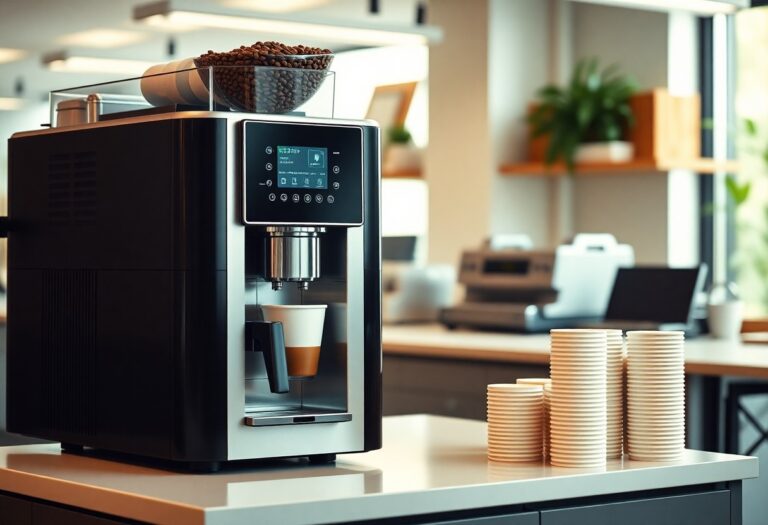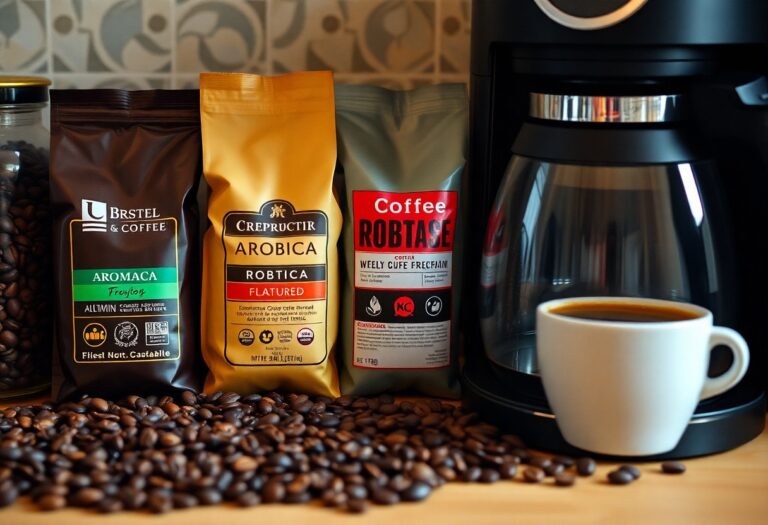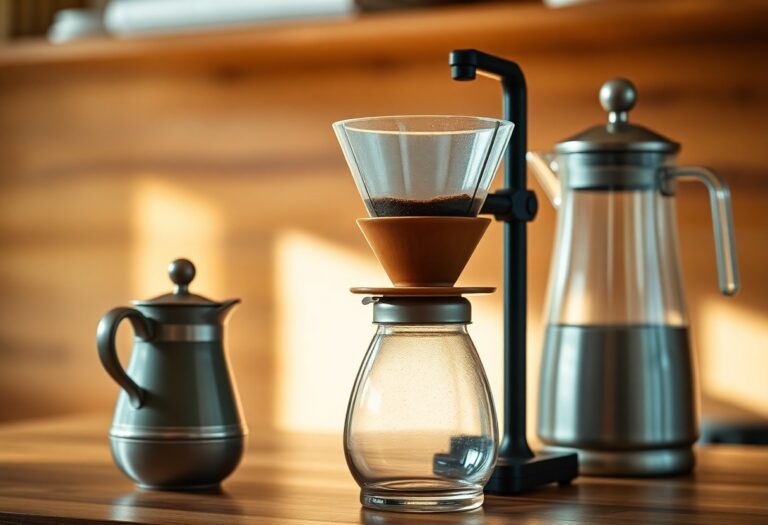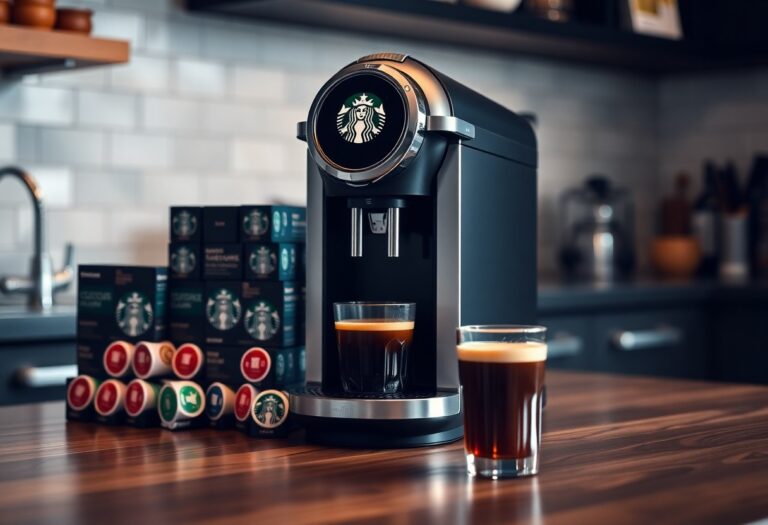What is an Espresso Coffee Machine – Pressure Brewing
Many coffee enthusiasts are drawn to the rich, bold flavors that an espresso coffee machine can create through pressure brewing. This method uses high pressure to extract the essence of coffee beans, resulting in a concentrated shot that delivers intense flavors and a distinctive crema. Understanding how your espresso machine functions, including its pump system and temperature control, will empower you to make the perfect espresso drink. Get ready to elevate your coffee experience by mastering the art of pressure brewing!
Key Takeaways:
- Espresso coffee machines use high pressure to force hot water through finely ground coffee, resulting in a concentrated coffee shot.
- The typical brewing pressure for espresso is around 9 bars, which is crucial for extracting the flavors and oils from the coffee grounds.
- Different types of espresso machines include manual, semi-automatic, and fully automatic, each offering varying levels of control over the brewing process.
- The quality of the espresso largely depends on factors such as the grind size, coffee dosage, water temperature, and extraction time.
- Espresso serves as the base for various popular coffee drinks, including lattes, cappuccinos, and Americanos.

Demystifying Espresso: The Role of Pressure in Brewing
Understanding espresso requires grasping the significance of pressure in the brewing process. It’s not just about the machine; the pressure is fundamental to achieving that rich and complex flavor profile you love. When water is forced through the coffee grounds at the right pressure, it extracts necessary oils and flavors that contribute to the signature crema and full-bodied taste of espresso.
The Basics of Pressure Brewing
Pressure brewing involves utilizing a specific amount of force—usually around 9 bars—to push hot water through finely ground coffee. This method differs significantly from traditional brewing techniques, as the high pressure helps break down the coffee’s cell walls and extract flavor compounds efficiently. The result? A concentrated, aromatic shot that you can enjoy on its own or as the base for your favorite coffee drinks.
How Pressure Affects Flavor and Extraction
The extraction process is directly influenced by pressure, shaping both the taste and aroma of your espresso. Optimal pressure can enhance sweetness while minimizing bitterness, allowing you to appreciate the coffee’s unique notes. Variations in pressure can yield different flavors, meaning that slight adjustments can elevate your brew from ordinary to extraordinary.
For instance, brewing at lower pressures might produce a brewing shot with more acidic notes, while higher pressure tends to amplify chocolatey or nutty flavors. This delicate balance between pressure and extraction time is critical; the differences in profiles can be subtle yet impactful. Achieving the golden ratio—where you extract the optimum flavors—validates the artistry in crafting the perfect espresso, making it an exhilarating pursuit for coffee enthusiasts.

The Anatomy of an Espresso Machine: Components that Matter
Understanding the anatomy of an espresso machine can significantly enhance your coffee-making experience. Each component plays a unique role, contributing to the overall brewing process. From the water reservoir to the group head, every part has been meticulously designed to ensure optimal extraction and flavor. Knowing the purpose and function of these components allows you to troubleshoot any issues and even customize your setup, making your espresso journey more enjoyable and rewarding.
Key Parts: Pumps, Boilers, and Portafilters
The heart of any espresso machine lies in three main components: the pump, boiler, and portafilter. The pump generates the necessary pressure to force hot water through the coffee grounds, typically reaching between 9 to 15 bars. Meanwhile, the boiler heats water to the perfect temperature, often maintaining stability for consistent quality. The portafilter, which holds the coffee grounds, must create a good seal with the group head to ensure effective brewing. Together, these parts work harmoniously to produce rich, flavorful espresso.
The Importance of Precision in Engineering
Precision in engineering directly influences the quality of espresso you can produce. Small variations in pressure or temperature can lead to vastly different flavors in your coffee. For example, the ideal brewing temperature is typically between 90°C to 96°C, and deviating even slightly can result in either bitter or under-extracted brews. Manufacturers invest in advanced technologies and rigorous testing to ensure that their machines operate with remarkable accuracy. This attention to detail elevates your espresso experience, allowing you to enjoy café-quality brews in the comfort of your home.
Brewing Methods: Exploring Different Espresso Machine Types
The world of espresso brewing machines is diverse, providing various approaches to making the perfect cup of coffee. You’ll find machines that cater to both novices and professionals. Here’s a brief overview of common espresso machine types:
- Manual Machines
- Automatic Machines
- Super-Automatic Machines
- Lever Machines
- Portable Machines
Thou can explore machine types that fit your specific espresso-making style and preferences.
| Manual Machines | Automatic Machines |
| Gives complete control over the brewing process. | Convenient and easy to use, with consistent results. |
| Requires practice and skill. | May lack personalized adjustments. |
| Potentially lower cost. | Higher initial investment. |
| Can produce unique flavors. | Often includes advanced features. |
Lever Machines: The Art of Control
Lever machines represent a traditional approach to espresso brewing, allowing enthusiasts to experience the art of control. You engage with a manual lever to create pressure during extraction, which can cultivate a rich flavor profile. Lever machines require practice but reward you with unparalleled customization for each shot. Mastering the lever technique often leads to a unique, satisfying experience as you manipulate variables such as water temperature and pressure.
Advanced Techniques: Mastering Your Espresso Craft
Becoming a master espresso maker involves understanding the nuances of pressure brewing, grind size, and milk texturing. Refining your skills in these areas not only enhances the overall flavor of your coffee but also allows you to better express your style. Experimenting with different techniques will elevate your espresso experience to new heights. Here’s a roadmap to help you along your journey:
- Experiment with different grind sizes to find your sweet spot.
- Adjust your coffee dose for optimal extraction.
- Learn the art of texturing milk for lattes and cappuccinos.
- Understand how different bars of pressure impact your brew.
- Test your espresso shots for various brew times.
For further insights on how many bars of pressure for the perfect coffee and more, investigate various brewing techniques and optimal pressure settings.
| Technique | Description |
|---|---|
| Dialing in Your Grind Size | Finesse your grind to achieve the perfect extraction rate. |
| Milk Texturing | Steam milk to a creamy microfoam for your coffee. |
Dialing in Your Grind Size and Dose
Choosing the right grind size is necessary for optimal espresso extraction. Finer coffee grounds allow for increased surface area, resulting in quicker extraction times, while coarser grinds slow the process down. The ideal dose typically ranges from 18g to 20g for a double shot, but experimenting with these variables can reveal your perfect profile. By adjusting the grind and the amount of coffee used, you can enhance the flavor and body of your espresso.
Texturing Milk for the Perfect Cappuccino
Texturing milk plays a crucial role in creating a balanced cappuccino. Achieving the right froth involves using a steam wand to create microfoam that is both silky and dense. The goal is to incorporate air gently while heating the milk, transforming it into a velvety texture that complements the espresso shots perfectly. The angle and depth of your steam wand in the milk pitcher make a significant difference in achieving that barista-level outcome.
Utilizing the steam wand effectively will elevate your cappuccinos. Begin with cold milk in a metal pitcher, angling the wand to create a whirlpool effect. Keep the tip just below the surface to introduce air until you reach the desired frothiness. Once you’ve incorporated sufficient air, submerge the wand deeper to heat the milk evenly. Aim for a temperature around 150°F (65°C) for the best results — a well-textured milk creates a deliciously balanced drink that harmonizes with the richness of your espresso. Experiment with different levels of froth for varying drink styles, from a classic cappuccino to a creamy latte.
Common Misconceptions: Debunking Espresso Myths
Several myths surround the world of espresso that can distort your understanding and appreciation of this beloved beverage. One prevalent misconception is that espresso is a specific type of coffee bean; in reality, espresso can be made from any coffee bean, provided it is ground finely enough and brewed under high pressure. These myths often lead to confusion about how espresso fits into the broader category of coffee.
Espresso vs. Coffee: What’s the Difference?
Espresso and coffee differ primarily in their preparation methods rather than the beans themselves. Espresso is made by forcing hot water through finely-ground coffee under high pressure, resulting in a concentrated shot known for its rich flavor and creamy texture. In contrast, regular coffee is brewed using methods like drip or pour-over, which typically involve coarser grounds and longer extraction times.
The Belief in Espresso Intensity and Caffeine
A common belief holds that espresso packs more caffeine than regular coffee, but this isn’t entirely accurate. While a single shot of espresso contains roughly 63 milligrams of caffeine, an 8-ounce cup of regular coffee can contain 80 to 100 milligrams, depending on brew strength and coffee type. Therefore, in terms of volume, your cup of coffee can deliver a greater caffeine punch.
The perception of espresso as an intensely caffeinated beverage stems from its concentrated flavor and smaller serving size. When sipping a shot of espresso, you experience its rich characteristics and bold taste all at once, which can feel more stimulating. However, if your aim is to up your caffeine intake, consuming a larger volume of regular coffee may be more effective. This distinction is imperative for understanding your caffeine choices and enjoying your daily brews without misunderstanding the impact of each.
Final Words
Conclusively, understanding what an espresso coffee machine is and how pressure brewing works empowers you to make informed choices in your coffee-making journey. With the right machine, you can extract rich flavors and achieve that perfect crema, elevating your coffee experience. By learning about the various components and techniques involved in pressure brewing, you can customize your espresso shots to match your taste preferences and impress your guests.
FAQ
Q: What is an espresso coffee machine?
A: An espresso coffee machine is a specially designed appliance that brews coffee by forcing hot water through finely-ground coffee under high pressure. This process creates a concentrated form of coffee known as espresso, characterized by its rich flavor and thick crema, the golden layer that forms on top of the espresso shot.
Q: How does pressure brewing work in an espresso machine?
A: Pressure brewing in an espresso machine involves using a pump to create significant pressure (usually between 9 to 15 bars) to push hot water through the coffee grounds. This high-pressure extraction results in a quick brewing time, typically between 25 to 30 seconds, which enhances flavor extraction and produces the distinctive characteristics of espresso.
Q: What types of espresso machines are available?
A: There are several types of espresso machines, including manual, semi-automatic, automatic, and super-automatic machines. Manual machines require more skill, as the user controls the brewing process. Semi-automatic machines allow for some automation while giving the user control over brewing time. Automatic machines automate the water dispensing process, and super-automatic machines grind, tamp, brew, and dispense espresso with minimal user involvement.
Q: Are espresso machines only for making espresso?
A: While espresso machines are primarily designed to brew espresso, they can also be versatile. Many machines come with steam wands or milk frothers, allowing users to create a variety of coffee beverages such as lattes, cappuccinos, and macchiatos by adding steamed milk and milk foam.
Q: What factors should be considered when choosing an espresso machine?
A: When dicking out an espresso machine, consider factors such as your experience level, budget, space availability, and desired features. Beginners might prefer a user-friendly automatic machine, while experienced baristas may seek more control with a manual or semi-automatic machine. Also, look for build quality, ease of maintenance, and the availability of replacement parts and service.







